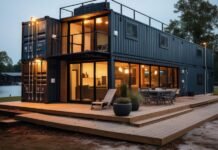In recent years, the world has witnessed a groundbreaking shift in the architectural landscape, where innovation meets environmental consciousness. Shipping container homes have emerged as a popular alternative to traditional housing, and their appeal lies in their adaptability, sustainability, and unique design aesthetics. This article explores the inventive uses of shipping containers in home design, with a particular focus on a striking example from Studio Edwards in Australia.
The Versatility of Shipping Containers
Shipping containers, typically made of corrugated steel, have long been utilized for transporting goods across the globe. However, their robust structure and modular nature have sparked a creative revolution in architecture. From single-family homes to schools and offices, these versatile containers can be transformed into virtually any type of dwelling. The design flexibility allows architects to stack, position, and connect containers in a myriad of configurations, resulting in eye-catching and functional living spaces.
One of the most exciting recent developments in this field is House 28, designed by the Melbourne-based Studio Edwards. Nestled on a scenic hillside in Wye River, Victoria, this weekend retreat is a prime example of how shipping containers can be transformed into a modern living space that harmonizes with its natural surroundings.
Sustainable Design: House 28
House 28 was created with sustainability at its core. The design integrates three 20-foot shipping containers sourced from nearby Port Melbourne, which are elegantly positioned on steel silts anchored in concrete piles. This elevated structure not only secures it against flooding but also maximizes the stunning views of the landscape and water.
The decision to use shipping containers aligns with environmentally friendly practices, contributing to a reduced carbon footprint in construction. Additionally, the containers are sheathed in galvanized steel sheeting for durability and weather resistance. This innovative approach not only repurposes materials that would otherwise contribute to waste but also showcases a commitment to sustainable living.
Innovative Features and Design
Inside, House 28 is a masterclass in minimalist design. Two of the containers form an open-plan living area that includes a lounge, kitchen, and a water closet, while the third container is slightly offset, accommodating two bedrooms and a bathroom. The interiors are clad with marine plywood, providing a warm and inviting atmosphere, while large windows allow natural light to flood the space, creating an airy and comfortable environment.
An additional highlight of House 28 is its green roof adorned with native plants, which enhances insulation during colder months. This not only helps to regulate indoor temperatures but also supports local biodiversity. Furthermore, the home features a rainwater filtration system that collects water for domestic use, emphasizing a self-sufficient lifestyle that minimizes reliance on municipal resources.
Outdoor Living: Embracing Nature
Recognizing the importance of blending indoor and outdoor spaces, House 28 incorporates a wooden deck that extends from the living area, providing a seamless transition to the outdoors. This deck area serves as an ideal spot for relaxation and entertainment, offering stunning views of the surrounding landscape—a perfect retreat for those seeking leisure and tranquility.
The alignment of the house facing toward natural vistas creates a strong connection between the inhabitants and their environment. This design choice not only enhances the quality of life for residents but also demonstrates a forward-thinking approach toward architecture—one that prioritizes the experience of living in harmony with nature.
The Future of Housing
House 28 exemplifies the potential of shipping container homes to redefine modern living. As urban spaces continue to grapple with challenges such as housing shortages and sustainability concerns, it is evident that innovative structures like this are becoming an essential part of the solution.
The growing popularity of shipping container homes is opening up new possibilities for affordable housing without compromising on quality or aesthetics. As architects and builders embrace this trend, we can expect to see continued growth in the design and construction of eco-friendly, resource-efficient homes that are both stylish and practical.
In conclusion, shipping container homes, such as House 28, represent a fascinating convergence of creativity, sustainability, and functionality. They offer a glimpse into a future where housing can be reimagined and reinvigorated, ultimately providing solutions to modern living challenges while celebrating the beauty of our natural surroundings. Whether you’re an architecture enthusiast or someone seeking alternative housing options, the world of shipping container homes promises to be an inspiring journey into the future.














